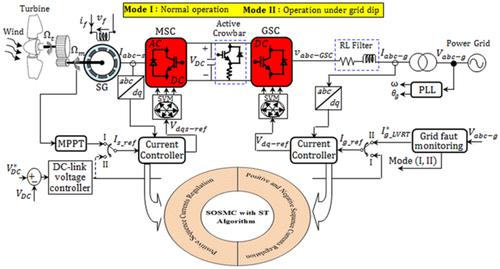当前位置:
X-MOL 学术
›
Int. J. Circ. Theory Appl.
›
论文详情
Our official English website, www.x-mol.net, welcomes your
feedback! (Note: you will need to create a separate account there.)
Second-order sliding mode control of wind turbines to enhance the fault-ride through capability under unbalanced grid faults
International Journal of Circuit Theory and Applications ( IF 1.8 ) Pub Date : 2021-04-19 , DOI: 10.1002/cta.3023 Khalfallah Tahir 1, 2 , Tayeb Allaoui 2 , Mouloud Denai 3 , Saad Mekhilef 4 , Cheikh Belfedal 2 , M'hamed Doumi 5
International Journal of Circuit Theory and Applications ( IF 1.8 ) Pub Date : 2021-04-19 , DOI: 10.1002/cta.3023 Khalfallah Tahir 1, 2 , Tayeb Allaoui 2 , Mouloud Denai 3 , Saad Mekhilef 4 , Cheikh Belfedal 2 , M'hamed Doumi 5
Affiliation

|
The integration of wind generation to the grid is growing rapidly across the world. As a result, grid operators have introduced the so-called grid codes (GC), which nowadays include a range of technical conditions and requirements, which wind generators must fulfill. Among these, the low-voltage ride through (LVRT) is a requirement for wind turbines to stay connected to the grid and continue to operate during the disturbance. In this study, a control structure, combining inertial kinetic energy storage with a crowbar circuit, is proposed to enhance the ride through capability of a wind turbine generator (WTG) based on a wound-field synchronous generator (WFSG) under unsymmetrical voltage dips. For the grid-side converter (GSC), a decoupled double synchronous reference frame (DDSRF) d-q current controller is used. Furthermore, a second-order sliding mode controller (SOSMC) with super-twisting (ST) algorithm is proposed for the GSC and the machine-side converter (MSC) to improve the response speed and achieve an accurate regulation of the dq-axis current components simultaneously. The main objectives of the GSC are to achieve a balanced, sinusoidal current and smooth the real and reactive powers to reduce the influence of the negative-sequence voltage. A series of simulations are presented to demonstrate the effectiveness of the proposed control scheme in improving the LVRT capability of the WFSG-driven wind turbine and the power quality of the system under unbalanced grid voltage conditions.
中文翻译:

风电机组二阶滑模控制提高电网不平衡故障下的故障穿越能力
风力发电与电网的整合正在世界范围内迅速发展。因此,电网运营商引入了所谓的电网规范 (GC),如今该规范包括一系列风力发电机必须满足的技术条件和要求。其中,低电压穿越(LVRT)是风力涡轮机在扰动期间保持与电网连接并继续运行的要求。在这项研究中,提出了一种将惯性动能存储与撬棒电路相结合的控制结构,以提高基于绕线同步发电机 (WFSG) 的风力涡轮发电机 (WTG) 在不对称电压骤降下的穿越能力。对于网侧变流器 (GSC),解耦双同步参考系 (DDSRF) d - q使用电流控制器。此外,针对GSC和机侧转换器(MSC)提出了具有超扭曲(ST)算法的二阶滑模控制器(SOSMC),以提高响应速度并实现dq轴电流的精确调节组件同时进行。GSC 的主要目标是实现平衡的正弦电流并平滑有功和无功功率,以减少负序电压的影响。一系列仿真结果证明了所提出的控制方案在提高 WFSG 驱动风力涡轮机的 LVRT 能力和电网电压不平衡条件下系统电能质量方面的有效性。
更新日期:2021-04-19
中文翻译:

风电机组二阶滑模控制提高电网不平衡故障下的故障穿越能力
风力发电与电网的整合正在世界范围内迅速发展。因此,电网运营商引入了所谓的电网规范 (GC),如今该规范包括一系列风力发电机必须满足的技术条件和要求。其中,低电压穿越(LVRT)是风力涡轮机在扰动期间保持与电网连接并继续运行的要求。在这项研究中,提出了一种将惯性动能存储与撬棒电路相结合的控制结构,以提高基于绕线同步发电机 (WFSG) 的风力涡轮发电机 (WTG) 在不对称电压骤降下的穿越能力。对于网侧变流器 (GSC),解耦双同步参考系 (DDSRF) d - q使用电流控制器。此外,针对GSC和机侧转换器(MSC)提出了具有超扭曲(ST)算法的二阶滑模控制器(SOSMC),以提高响应速度并实现dq轴电流的精确调节组件同时进行。GSC 的主要目标是实现平衡的正弦电流并平滑有功和无功功率,以减少负序电压的影响。一系列仿真结果证明了所提出的控制方案在提高 WFSG 驱动风力涡轮机的 LVRT 能力和电网电压不平衡条件下系统电能质量方面的有效性。











































 京公网安备 11010802027423号
京公网安备 11010802027423号